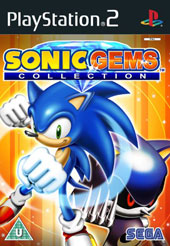
Giving a handful of games BBFC ratings is nothing new as any games with significant violent or sexual content will usually lead to the publisher paying to get one by choice, both to protect themselves from angry right-wing newspapers and because it’s something of a badge of honour to anyone under 18 to get their smelly little hands on them. Obviously the Manhunts and Grand Theft Autos of the world get those big red 18 ratings on the front covers but the kiddie platformers stuck with the unenforced PEGI ratings (the European equivalent of the American ELSPA ratings). Over the last few weeks, however, I’ve seen this changing.
You can probably see from the attached picture that Sonic Gems Collection, obviously not the most adult game in the world (although Sonic is clearly punching violently and Metal Sonic is gesturing aggressively with his frightening claws), has the big green “U” triangle, the same as a “G” rating. It obviously wouldn’t require it since it’s exempt from classification, so why would Sega pay to get it rated when they don’t need to?
I should also point out that Sonic Gems Collection isn’t the only game to do this, but it’s the only one I could find with its cover art on Amazon. I know that today I saw a new classic arcade compilation (I forget which one since they’re all identical and similarly overpriced) which carried a “U” rating, and although I can’t remember specifics there were several more which had “U” and “PG” ratings, neither of which would have warranted a BBFC rating.
A game can actually be as violent and depraved as it wants without being forced to get a rating (video games are exempt from classification under the Video Recordings Act 1984, as amended in 1993, at the moment), but the companies go for them anyway to cover their ass in case a kid gets hold of it and does something stupid. That way they can say that the 18 rating makes it illegal for someone under 18 to buy it and so it wasn’t their fault since they did everything they could have legally done to keep it out of underage hands.
The reason for this odd phenomenon with games aimed at a younger audience is almost certainly the same reason that they choose to go for the ratings on adult games – parents don’t know what PEGI is but they’ve grown up with BBFC ratings, and having them on some games and not others just seems to devalue them. By slapping those ratings (and oversized ones at that) on there they’re hoping that people will actually take notice and not be confused by them. If the industry is to stop people jumping on them whenever a kid does something bad, it’s important that they do what they can to help people understand that games aren’t a thing only for kids to play anymore and that nowadays your wholesome platform hero is just as likely to swear profusely and pull out a bazooka as he is to pick up magic flowers on his way to rescue the princess. Until the public get this into their thick skulls it’s important that the industry does what it can to raise awareness.
